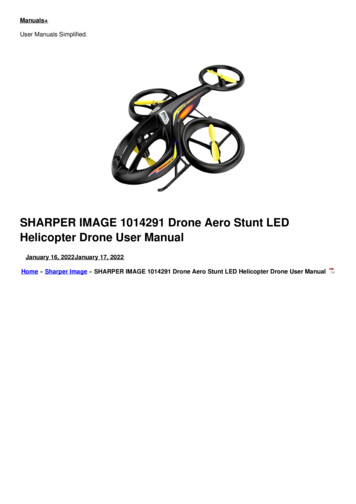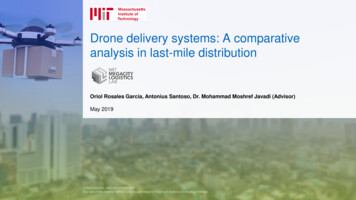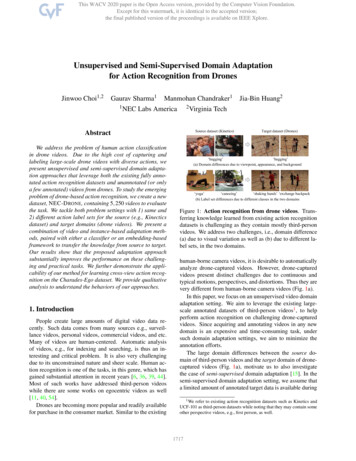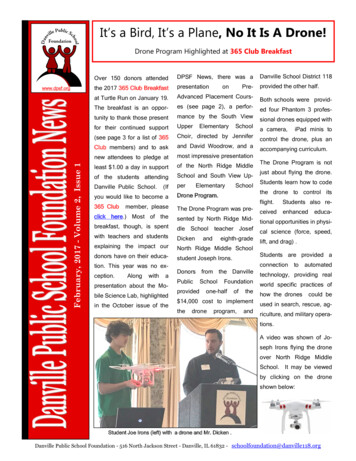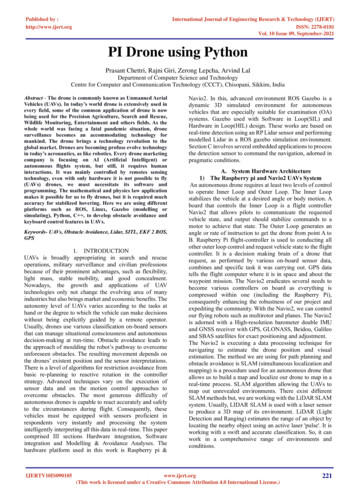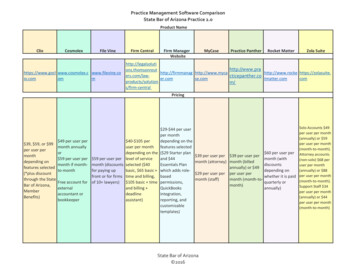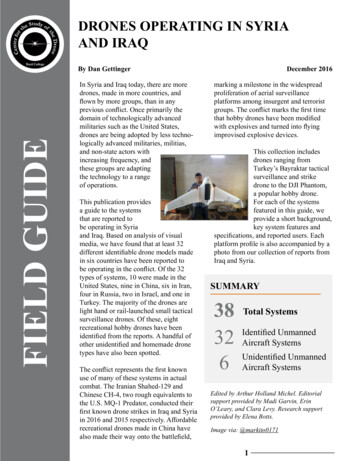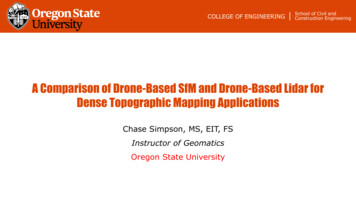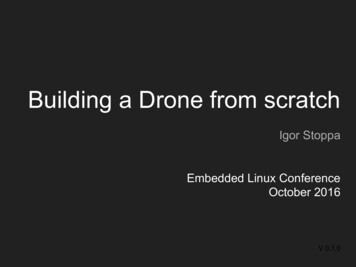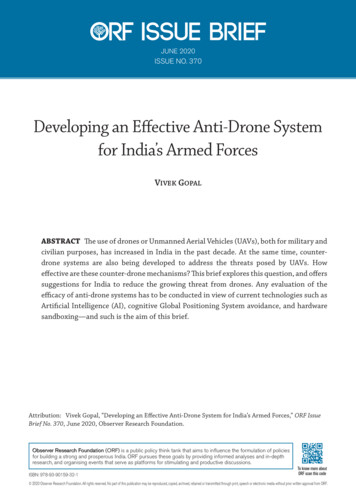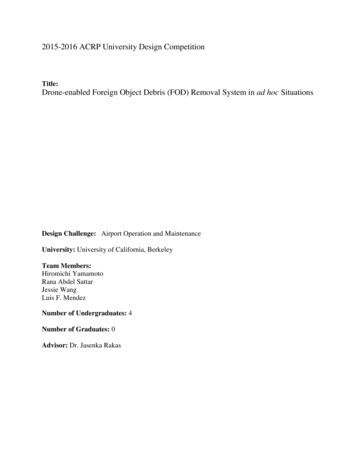
Transcription
2015-2016 ACRP University Design CompetitionTitle:Drone-enabled Foreign Object Debris (FOD) Removal System in ad hoc SituationsDesign Challenge: Airport Operation and MaintenanceUniversity: University of California, BerkeleyTeam Members:Hiromichi YamamotoRana Abdel SattarJessie WangLuis F. MendezNumber of Undergraduates: 4Number of Graduates: 0Advisor: Dr. Jasenka Rakas
EXECUTIVE SUMMARYForeign object debris (FOD) can cause significant problems at airports – even thesmallest piece of debris can pose major hazards to safe airport operations. Although intensiveFOD monitoring and removal strategies are already implemented, an estimated 4 billion fromrelated damages are recorded annually. Exploring improved preventative measures is essential toreduce financial risks and ensure safer air travel.In this study we propose a novel system that will introduce unmanned aerial vehicles(UAVs-- also referred to as unmanned aircraft systems (UASs) or drones --the terms will be usedinterchangeably) to be tasked with removing FOD in select situations. When implemented, theproposal will increase the safety of airport operations while maintaining efficient handling ofhigh-volume air traffic. We recommend this system to work as a supplementary tool to existingmaintenance and FOD removal strategies. From the standpoint of feasibility and safety concerns,this proposal will not explore options for a fully autonomous system.The drones will be dispatched in situations where this method will be superior to preexisting methods (ground vehicles and personnel dispatchment). Potential scenarios includeoccurrences when (a) debris is sufficiently small, common and isolated, (b) debris is too far froma maintenance vehicle or station, and (c) when high-speed removal is required.The main goals of the design will be increased safety, reduced financial risk, potentialincrease in airport capacity, and further innovation in airport operations and UAS technologies.Through a case study and financial analysis of the commercial viability of the idea, we believethis proposal has great potential to be implemented in the near future.
TABLE OF CONTENTS1 - PROBLEM STATEMENT . 12 - BACKGROUND . 13 - LITERATURE REVIEW . 33.1 - FOD DETECTION . . 33.2 - DRONES . . 53.3 - CRITIQUE OF EXISTING PROPOSALS . 74 - DESIGN DESCRIPTION 94.1 - RADAR . 94.2 - DECISION PROCESS IN DRONE DISPATCHMENT . . 104.3 - OPERATING THE DRONES . . 124.4 - TECHNICAL ASPECTS OF DRONE FLEET AND SYSTEM . . 144.5 - STABILITY CONSIDERATIONS . . 175 - SAFETY CONSIDERATIONS . . 175.1 - IDENTIFYING POTENTIAL HAZARDS . . 175.2 - COMBATING THE INHERENT RISKS . . 206 - INTERACTION WITH INDUSTRY EXPERTS . 217 - BENEFITS OF DESIGN . . 237.1 - INCREASED SAFETY . . 237.2 - REDUCED FINANCIAL RISK . 247.3 - INCREASED CAPACITY . 247.4 - COST-BENEFIT ANALYSIS . . 257.5 - COMMERCIAL VIABILITY . . 288 - CONCLUSION . . . 29APPENDIX A - CONTACT INFORMATION . . 31APPENDIX B - DESCRIPTION OF THE UNIVERSITY . . 32APPENDIX C - NON-UNIVERSITY PARTNERS . . 33APPENDIX D - DESIGN SUBMISSION FORM . 34APPENDIX E - EVALUATION OF EDUCATIONAL EXPERIENCE . . 35APPENDIX F – REFERENCES . . . 38LIST OF FIGURESFigure 1: Example of FOD found on runways . 2Figure 2a (left): Model HSP Airport Runway Sweeper . . 2Figure 2b (right): FOD-Razor Airport Runway Sweeper, single mat version . 2Figure 3: FODetect sensors at Boston Logan Airport . . . 5Figure 4: MD4-1000 . 6Figure 5: Prototype of Eagle claw drone . 7Figure 6: Flowchart of decision-making process of dispatching a drone for FOD removal . 11Figure 7: A potential scenario of high-speed FOD removal. The drone will allow for quickremoval of the debris without interfering with planned landings . 12Figure 8: Cross-departmental collaboration scheme of UAV-enabled FOD removal . 13Figure 9: Procedure of determining the optimal station number and their locations . 15
Figure 10: Image of drone station to be placed strategically around the airport (produced onCAD) . . 16Figure 11: Risk Acceptability Matrix . . . 19Figure 12: An interceptor drone catching a smaller drone in its net . . 21Figure 13: Group photo of UC Berkeley students at LAX on-site tour . . 23Figure 14: Location of 9/27 Runway at BOS and proposed station location . 25LIST OF TABLESTable 1: Notable FOD detection technologies . . . 4Table 2a: List of potential hazards and the corresponding levels of risk . . 18Table 2b: Severity Definitions set by FAA . . . 18Table 2c: Likelihood Definitions set by FAA . . . 19Table 3: Passenger data at Boston Logan and capacity of B737-300 . 26Table 4: Further data at Boston Logan 26
1 PROBLEM STATEMENTForeign object debris (FOD) can cause significant problems at airports – even thesmallest piece of debris can pose major hazards to safe airport operations. Although intensiveFOD monitoring and removal strategies are already implemented, many FOD-related damagesare recorded annually. It is of essence to explore improved preventative measures in order toreduce financial risks and ensure safer air travel.In this study we introduce a drone-enabled system tasked with removing FOD in selectsituations. When implemented, the proposal will increase the safety of airport operations whilemaintaining efficient handling of high-volume air traffic. We recommend this system to work asa supplementary tool to existing maintenance and FOD removal strategies. From feasibility andsafety concerns, this proposal will not explore options for a fully autonomous system.2 BACKGROUNDIn 2000 the historical Air France Concorde crash killed all 109 people on board and 4 onthe ground as a result of foreign object debris on a runway [1]. Following this tragic event,airport officials worldwide have strived to improve debris detection and removal systems toavoid similar future runway occurrences.Foreign object debris (FOD) is classified as “any object, live or not, located in aninappropriate location in the airport environment that has the capacity to injure airport or aircarrier personnel and damage aircraft” [2]. Common sources of debris currently found on therunway include: parts of airport infrastructure that has deteriorated; miscellaneous items fallenoff from the aircraft, such as luggage tags; and random objects, such as plastic and polyethylenematerials that have landed on the runway via wind or environmental conditions. Debris can varyin size and type, from a small golf ball to a piece of aircraft as shown in Figure 1.1
Boeing has estimated that FOD on therunway results in approximately 4 billion a yearin damage costs [2]. To repair a single damagedengine can range anywhere from 250 thousandto 10 million, depending on the type of engine[4]. The result of FOD damaging aircraft leviesheavy tolls on the airlines that must repair theirFigure 1: Example of FOD found on runways. [3]aircraft. FOD on the runway also imposes highcosts to airports that make revenue from the operations run per day.In efforts to improve runway safety airports have implemented intense FOD preventionprograms. Technologies such as power sweepers, vacuum systems, and jet air blowers collectand remove FOD using mechanical means (Figure 2a). Non-mechanical devices, such as frictionmat sweepers, magnetic bars, and rumble strips, are used, as well (Figure 2b).Figure 2a (left): Model HSP Airport Runway Sweeper. [5]Figure 2b (right): FOD-Razor Airport Runway Sweeper, single mat version. [6]As for FOD detection systems, new radar sensor technologies have been implemented inselect airports. These sensors complement visual human observations from vehicles on therunways or from the air traffic control tower, further improving detection accuracy.2
This paper presents the idea of combining these emerging technologies into one systemthat would provide the service of both detecting and collecting foreign object debris in selectsituations. This new innovative system of incorporating an integrated drone system would vastlyreduce runway closure time as well as accurately remove all debris off the runways, maximizingsafety and airport operations.3 LITERATURE REVIEWVarious ground-based FOD removal and detection equipment are currently used tomaintain safe and efficient runway operations at airports. In this section detection system andunmanned aerial vehicle (UAV) applications that could be useful in achieving the drone-enabledFOD removal idea are reviewed. Additionally, two relevant anti-FOD proposals will be critiqued.3.1 FOD DETECTIONA number of FOD detection systems already exist at some major airports. A notablesystem implemented is the “FODetect” solution at Boston Logan International (BOS) Airport.Developed by XSight, this technology can detect debris through a system of camera/sensorsmounted on airport lighting fixtures (Figure 3). “FODetect” integrates sensor scanningcapabilities with a software platform to scan, detect, alert, and analyze the occurrences of runwayobstructions. Sixty-eight electro-optic and radar sensors are placed at 200-feet intervals parallelto BOS’ busiest runway [7]. These sensors scan the runway in 60 seconds and can find debris assmall as an aircraft rivet. When a sensor detects something, information (such as an alarmmessage and video footage) is sent to an operator so crew can be dispatched to remove theforeign objects, such as debris and birds [8]. FAA studies have concluded this system as3
effective in being “able to detect objects of various sizes, shapes and materials on runwaysurfaces and perform satisfactorily in nighttime, daytime sun, rain, mist, fog, and snow” [9].Other technologies are compared in Table 1. The “Tarsier Radar” [10] at TheodoreFrancis Green State Airport (PVD), Providence, RI and “iFerret” [11] at Chicago O’Hare (ORD)International airport install cameras attached onto towers to closely monitor conditions onrunways. The “FOD Finder” [12], also at ORD, mounts sensors on the roof of airport vehicles,and obstructions are detected by driving around the airport taxiways and runways. Thesesolutions are less extensive than the full sensor system, such as the ”FODetect” technology, andeasier to implement. The “FOD Finder,” especially, is considered as a low-cost solution.Table 1: Notable FOD detection technologies. [13]Detection SystemsInstrumentationSummaryFODetect Millimeter wave radarHigh resolution cameraHybrid system of unique integrated optic sensorwith NIR illumination and a millimeter-waveradar sensing technology in Surface DetectionUnits (SUDs) along the runway.Tarsier Radar Millimeter wave radarHigh resolution cameramounted on rigid towersMillimeter wave radar is used to giveuninterrupted coverage of the runway, whileobject identification is enabled by a powerfulday and night camera system, cued onto theobject automatically. Camera provides livefootage once an FOD has been identified tofacilitate its classification and removal.iFerret High resolution cameraIntelligent vision-based FOD detection systemMounted on rigid towers providing real time, automated detection,location, classification, and recording.FOD Finder Millimeter wave radarMulti-axis infraredcamera/video sensortracking ball mountedon roof of vehicles orfixed to any flat surfaceMobile/fixed millimeter wave radar that locatesFOD in a single pass with a 600 ft. diameter(wide) radar sweep covering the full width ofthe runway, its shoulders and approachingtaxiways/high speed turnoffs.4
Implementing these surveillance systems comes with a pricetag. These technologies, however, are not as overpriced as one mayassume. For instance, the Xsight system at BOS airport costs 1.7million to install, with 900,000 covered by the FAA. Naturally,pricing depends on the length of the runway. Runway 9/27 (7,000feet) at BOS is relatively short, and “ 5-6 million is a good ballparkfor longer runways” [8]. Nonetheless, the FAA reports an annualFigure 3: FODetect sensors atestimate of 4 billion to correct FOD damage [4]. Especially at busy Boston Logan Airport. [14]airports, spending to implement these types of systems seems to be a beneficial tradeoff toreduce economic losses caused by debris. Indeed, from an operational standpoint, XSight claimsthat the FODetect increases runway capacity, adding up to four slots per hour [15].3.2 DRONESDrones are getting increasing attention for future widespread use. Notable advancementsin this field of study are currently occurring, enabling drones to be more easily used as elementsin an innovative FOD removal system.For instance, UC Berkeley’s Center for Collaborative Control of Unmanned Vehicles(C3UV) is a leading research center in the field of drone operations. The Center explores thetechnical feasibility of drones in complex maneuvers such as FOD detection and removal. Sincerunway surfaces are flat, have no obstructions, and are surrounded with an abundance of openspace, drones possess high applicability for extensive debris identification. An extension of thiscapability is C3UV’s development of a Collaborative Sensing Language (CSL) on a GraphicalUser Interface (GUI) platform. Enabling real-time network communications between drones andthe control interface, these tools should be capable of accurately locating a target on the runway.5
The sensor-centered system discussed earlier is not the only strategy in implementing automatedFOD detection; drones themselves can also locate targets in a sophisticated manner [16].Developments in the mechanical aspects of drones provide promising outlook as well.Importance is stressed to ensure that the drones operating to remove FOD will not become FODthemselves. Swiss-based company, Flyability, is developing “Gimball,” which is “the first‘collision-tolerant drone,’ utilizing a rotating spherical outer cage [ ] designed to enter hostileenvironments [.] and navigating restricted areas” [17]. As the winner of the “Drones for Good”international competition in February 2015, outlooks on improving upon the fragile structure ofdrones seems promising in the future.High-speed and accuratepayload pickup maneuvers are alsovital. These maneuvers can beenhanced by using controlledmanual quadcopters: this can ensurethe best attainable accuracy andFigure 4: MD4-1000. [18]grabbing mechanism of the target (R.Sengupta, personal communication, February 27, 2016). In today’s market, there are just a fewhigh-end quadcopters capable of performing safely in any weather conditions. The MD4-1000(Figure 4) from Microdrones is a good example: it has high performance capabilities in anyweather condition [18].Another contrasting yet promising idea is a prototype for an “eagle claw” drone (Figure5) that can pick up payloads at high speeds. A team of researchers of the GRASP Lab at theUniversity of Pennsylvania have designed a drone to grasp and retrieve objects at high speeds.6
The mechanism mimics that of aerial predators to achieve an efficient method of picking up atarget, compared to a “traditional” image of drones stopping and hovering while trying to graspsomething, wasting fuel and time [19]. The fusion of these concepts can be significant inattaining both accuracy and efficiency in the removal of runway debris by drones.Although advanced sensor andUAV technologies already exist, this is aresearch area that may be furtherintegrated in many different ways.Developments in FOD removaloperations is no exception: our proposalpromises to become an innovative andFigure 5: Prototype of eagle claw drone. [19]beneficial investment.3.3 CRITIQUE OF EXISTING PROPOSALSRecent research has explored FOD removal strategies using automation techniques androbots. This section discusses the limitations of traditional land-robots, as well as the risks andinfeasibility of a full-automation system.In 2012 a group of undergraduate mechanical engineers from Tufts University designed anew robotic automated debris collection system, which they have named FODHippo. Similar toour design, the design goal is to integrate existing detection technologies with the FOD retrievalsystem, while improving upon safety and maximizing runway capacity. This project ideallyeliminates the need for personal human interference to retrieve FOD directly from runways.Based on robotic prototypes, the target round-trip retrieval time of FODHippo system is 37
minutes, which is significantly lower than the estimated standard today of roughly 10 minutesper FOD removal [20].Likewise, our FOD removal design aims to increase runway safety while creatingeconomic benefits. Both of the ideas employ remote-controlled machinery; however, drones willbe superior to land-based robots from an efficiency standpoint. Drones are able to fly andretrieve the FOD swiftly from the ground by taking the shortest possible path, eliminating anysort of ground obstacles that might appear for FODHippo robots. Furthermore, as the FODHippois a ground vehicle, it has a higher chance of creating FOD itself, whether it be from droppingdebris during transport, wear and tear of the machine from friction, higher chance of crashinginto obstructions, or parts of the robot falling off. As assessed by Boeing, the benefit would bethe drone’s ability to approach the debris on the runway from over the grass where a vehiclecannot operate: anything that keeps a vehicle off a runway will improve safety (B. Bachtel,personal communication, April 19, 2016).The more significant issue is that any fully automated system can have substantial risk inmalfunctioning, especially in rare conditions such as extreme weather conditions. Removinghuman factors from the debris removal process, where each occurrence is unique, will createsignificant safety concerns.A concept of multi-robot coordination for autonomous runway FOD clearance wasdiscussed by Öztürk and Kuzucuoğlu [21]. Much like the FODHippo system, their study alsosuggests an entirely automated system with no human intervention. To avoid all technologicalrisks or accidents, however, the drone system should be managed and operated by UASprofessionals who will be controlling the drone from afar making sure that every removal step iscompleted without any further complications that could potentially create a hazard.8
Combining our research findings with the existing literature, our proposed drone FODremoval system seems to overcome some of the limitations found in other removal strategies. Aspresented in this study, our design is targeted to be the safest and most reliable FOD removalsystem of all known, existing proposals.4 DESIGN DESCRIPTIONAs discussed in our preliminary research, having an effective FOD removal strategy isextremely important in securing safety of runway operations. Many proposals, such as theFODHippo and a multi-robot coordination approach, provide initiatives to combat risksassociated with FOD; however, they fail to take into consideration many factors required for afeasible and successful system. This paper presents an innovative idea of a drone-enabled systemtasked with removing FOD in select situations. When implemented, the proposal will increasethe safety of airport operations while maintaining efficient handling of high-volume air traffic.Contrary to other ideas, we recommend this system to work as a supplementary tool to existingmaintenance and FOD removal strategies. From feasibility and safety standpoints, this proposalwill not explore options for a fully autonomous system.4.1 RADARIntegrating sophisticated FOD detection technologies within the system is vital for thesuccessful implementation of our design proposal. Before the drones will be considered to bedispatched, the FOD removal team division will closely monitor runway conditions, and look forany alerts arising from the radar system. As explained previously, technologies, like theFODetect solution at BOS, will provide accurate information regarding potential obstructions in9
a timely manner. Using the advanced radar technologies will provide accurate information to thedebris removal team, so they can make correct decisions accordingly.4.2 DECISION PROCESS IN DRONE DISPATCHMENTOnce a piece of debris is located and identified, the FOD removal team division willdetermine its next actions. Unlike existing proposals, which assume dispatching a robot for allscenarios, a decision must be made whether or not the debris will be removed by drone (newmethod) or ground vehicle (traditional method). The rationale is that it will be unrealistic to haveUASs (or any type of automated robot, in that sense) address every single obstruction andreplace regular maintenance schedules: this would require an unrealistically large fleet for theoption to be financially and systematically viable. Although UAS research is an emerging fieldwith much advancement in recent years, the application of drones to FOD removal is still inuncharted territory. We anticipate that our proposed design will facilitate further explorations ofthis proposal.Nonetheless, the drones will be useful in removing FOD in ad hoc situations. Figure 6displays a simplified flowchart of the specific procedure in deciding when the dispatchment ofthe UAS will be acceptable. The debris removal drones will be dispatched in situations wherethis method will be superior to pre-existing methods (such as power sweeping and manualremoval). Potential scenarios include occurrences when debris is sufficiently small, common,and isolated; debris is too far from a maintenance vehicle or station; and when high-speedremoval is required (such as when a runway cannot be closed down due to an oncoming landing,shown in Figure 7). UASs can provide several advantages to FOD-- most notably their swiftnessand short overall time requirements for removal. The limitations are that only one piece of FODcan be removed by one machine at one time and that some debris may not be suitable for pickup10
(because of size, weight, texture, for example); these cases would require normal vehicles to bedispatched.Figure 6: Flowchart of decision-making process of dispatching a drone for FOD removal.As the proposal assumes a holistic approach, other factors may be considered fordispatchment as well. Weather will be a significant element: in times of poor visibility conditions(such as rain, fog, or snow), operating the drones may not be efficient; rather, they may very wellbe an additional hazard to airport operations. Furthermore, during congested times of the airport,aircraft will be obstructions to the UASs’ paths. Additional cases of obstructions, like the aircraftduring peak hours, must also be considered in the decision-making process.11
4.3 OPERATING THE DRONESTo reiterate, all UASrelated decisions will rely heavilyon heuristics. Although advancedtechnology already exists,maintaining a human element inthe process will be reassuring toairport officials, pilots, andpassengers alike. Airtransportation is the safest mode ofFigure 7: A potential scenario of high-speed FOD removal. Thedrone will allow for quick removal of the debris without interferingwith planned landings.transport (J. Rakas, personal communication, August 25, 2015), so it will not be worth the risk toconvert the entire system to an automated system.With this fact clarified, if the requirements are fulfilled and a drone removal procedure isapproved, the drone pilots will be in charge of controlling and monitoring the process. Pilotingthe drone will be a “teleoperating” process: because UASs are unmanned, maneuveringprocedures will be performed off-site in a distant control room. Drone operations are veryhuman-intensive. Current FAA requirements mandate UASs to be operated by two navigators:the pilot in command (PIC), who will perform the maneuvering procedures, and the visualobserver (VO), who will fly the drone through the nose (and use the attached camera to interpretthe surrounding environment) [22]. For additional safety considerations, “UAVs @ Berkeley”recommends using a third person, who will oversee both pilots (D. Hooper, personalcommunication, April 7, 2016). Flying an aircraft requires a minimum of two operators, who are12
the pilots and the air traffic control (ATC) personnel; drones are similar in this sense that a multifaceted team must be formed to use the UASs efficiently.As one can deduce, the new proposal requires close cooperation. Because drones musttravel safely in the airport’s airspace, the ATC must be responsible to ensure unobstructed travel.Three officials should be tasked with operating the drone: the manager and the two pilots will sitwith the FOD detection and removal team, with the manager keeping constant contact with adesignated ATC official sitting in the tower (Figure 8). Initially, maneuvering drones might seemto be very labor-intensive and inefficient; however, it is assumed that the strict drone removaldispatch requirements (only in ad hoc situations) will not cause too many issues. Furthermore,advancements in controltechnologies and safety mayreduce strains experiencedduring the process.Although constantcommunication between theUAS team and the ATC isessential, getting supportfrom other departments isFigure 8: Cross-departmental collaboration scheme of UAV-enabled FODremoval.vital as well. As depicted inFigure 8, the ATC,maintenance team, runway scanning team, traditional FOD removal team, and the IT departmentare important entities that will provide the drone control squad with information and services that13
are valuable in ensuring smooth operations. Airport officials will be tasked to design a schemethat holds all related players accountable.4.4 TECHNICAL ASPECTS OF DRONE FLEET AND SYSTEMThe airport will maintain a fleet of drones to be used for the selective FOD removalprocedures. The number of drones to be implemented will depend on various factors such asairport capacity, runway quantity, length, and locations, and frequency of FOD. We can assumethat a small number of drones will be installed at each drone station.Drone stations, which will be the “bases” where the drones will be dispatched from andreturn to, will be strategically placed around the airport. These stations will be situated so that allareas of the airport can be accessed in a reasonable amount of time. Figure 9 outlines a methodthat airports can use to compute the optimal number and locations of drone stations to be placedon its site. First, historical data of all FOD occurrences is collected. All of these occurrences willbe labeled as a specific instance (point), and information on latitude, longitude, and debris typewill be recorded. This information will be entered into a computer algorithm in the form of a pmedian problem, to minimize the aggregate distance from the potential station location to eachFOD occurrence. The model will be run for various scenarios of p, which is the number ofstations to be built at the airport. The problem can be formulated as an integer linear program andsolved using software such as Gurobi, CPLEX, and Lindo. Alternatively, using the NetworkAnalyst tool in the ArcGIS interface will allow for easy visual representation of the results. Oncea set of solutions is obtained, sensitivity analysis should be conducted to determine the optimalplan of locating the stations, taking into consideration the number of stations, cost, overalldistance required for removal, and other miscellaneous limitations. Specifically, tradeoffs should14
be considered (cost of building an additional station vs. distance able to be minimized as a resultof this) to determine the optimal number of stations to be built.Figure 9: Procedure of determining the optimal station number and their locations.To ensure the new facilities will not be an obstruction in the airside, the structure willhave a low height and will be covered to ensure safe drone parking. During idle times, droneswill be parked here and charged, to be ready whenever called upon. Figure 10 below illustratesthe image of the drone station to be built.15
Figure 10: Image of drone station to be placed strategically around the airport (produced on CAD). Not to scale.The fleet mix at each station will be varied to accommodate pickup of different types of FOD. Toremove debris efficiently from the smallest pebble to a well-sized tree branch, small, medium,and large drones should be installed to ensure that the debris can be picked up without failure.Consideration should also be given to the material property of the debris: depending on what theitem is, the pickup maneuver should differ. For instance, based on the existing technologydiscussed, some drones should have an eagle-claw pickup capability, while others should have aquadcopter-enabled vertical pickup ability. To react to various situations, each drone station isrecommended to have UASs with differing characteristics.Furthermore, for the UASs to be visible during flight, the entire fleet should be equippedwith a transponder to allow the drone to be tracked precisely by ATC and FOD removalpersonnel at all times. Mounting special lighting fixtures will be useful for visibility pur
Foreign object debris (FOD) can cause significant problems at airports - even the smallest piece of debris can pose major hazards to safe airport operations. Although intensive FOD monitoring and removal strategies are already implemented, an estimated 4 billion from related damages are recorded annually.
